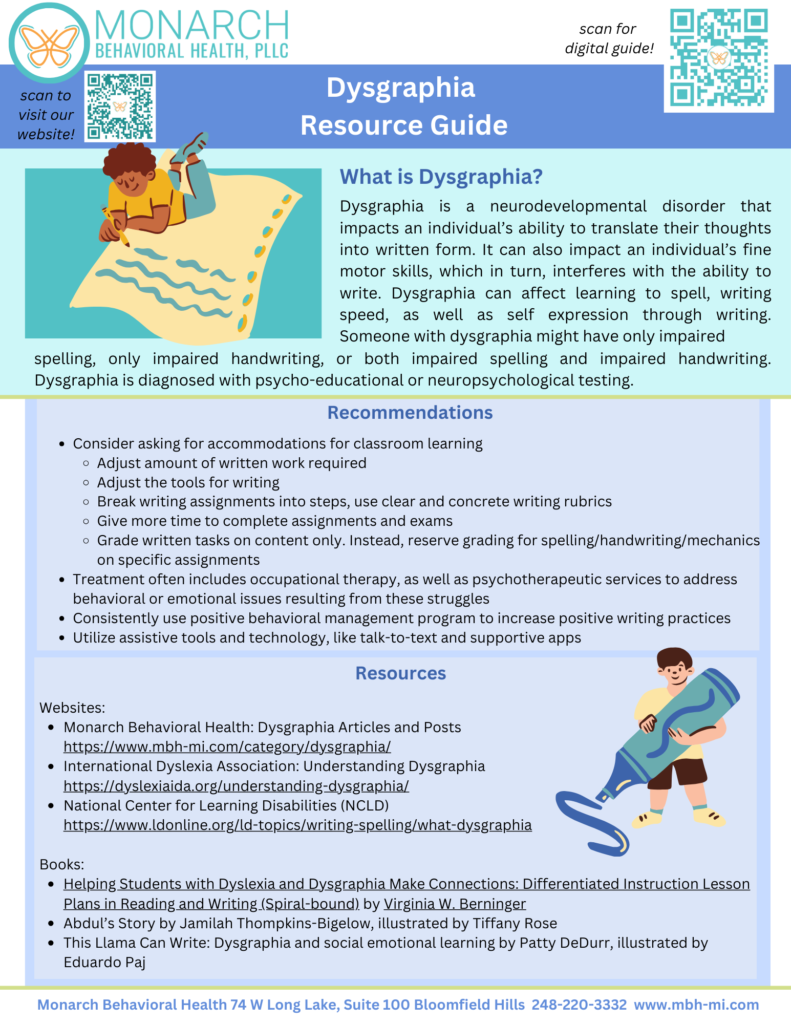Dysgraphia Resource Guide



Many kids and teens need Individualized Education Plans (IEP) to support their development and education. The IEP process can be an overwhelming and confusing path to navigate as a parent. We want to help make you feel prepared and informed about the process. The following steps are what will typically occur through the IEP process.


If you, as a parent, are concerned your child may be having learning struggles, social, emotional or behavioral difficulties that are interfering with learning, developmental delay, or any disability that is impacting their education needs you can begin the IEP process. The process begins with a formal request to receive comprehensive evaluation for special education eligibility. This evaluation assesses if your child qualifies for special education services. Each child with an IEP must be shown to qualify for services under one of several categories. This request can be verbal or written; although we recommend a written request for documentation purposes. The Michigan Alliance for Families has sample request letters available for parents to feel prepared without the hassle. We’ve included the link below for your convenience. It’s important to keep a dated copy of this request yourself for records. Someone within the school system who has concerns about your child’s learning or development can also make a request for an evaluation. You will be notified if this happens. Sometimes schools will gather data and/or put informal interventions into place before a child is formally referred for an IEP evaluation.
After a formal request has been submitted to the school they have 10 calendar days to respond. The school will either deny the request, stating the reasons why, or agree to conduct the evaluation. A (usually brief) meeting will then be held with parents to review the evaluation process and obtain written consent before the evaluation is conducted.
After the request has been made and accepted, the school assembles a Multidisciplinary Evaluation Team (MET) of professionals to evaluate your child. This team may include general education teachers, special education teachers, psychologists, social workers, therapists, or other specialists. This team engages in the Review of Existing Evaluation Data (REED) to determine what data they have regarding the areas of concern, as well as what additional evaluations must be completed. The team will develop a written report with recommendations for eligibility.
Evaluations are often requested because parents and/or teachers notice a child is struggling a great deal academically, socially, emotionally/behaviorally or developmentally, but they don’t know exactly why. It is important to know that the school does not and can not diagnose your child with a learning disability such as Dyslexia or Dysgraphia, language disorder, or neurodevelopmental disorder such as ADHD, Autism Spectrum Disorder, or Developmental Delay. These diagnoses can only be made by qualified professionals outside the school context. A diagnosis can support the case for eligibility in many cases.
Evaluations may be conducted during this time that look at academic functioning, behavioral/emotional functioning, executive functioning, and socio-emotional functioning within the classroom. You can also ask that private professionals, such as your psychologist or counselor are invited to be part of the MET and attend this meeting. The data from the evaluation guides what supports, accommodations and interventions your child may receive. If your child has a disability that has already been identified and documented by a professional (e.g.,. psychologist, medical doctor, speech pathologist, or occupational therapist) this process can be pretty straightforward.
Diagnoses having to do with learning (e.g., Dyslexia, Dysgraphia, Dyscalculia), socio-emotional or behavioral functioning, neurodevelopment (e.g., ADHD), or developmental delay are generally made by psychologists who work at an outpatient clinic or hospital setting, outside of the school. These diagnoses are typically made after a full psycho-educational or neuropsychological evaluation has been completed. Head over to the psychological assessment/testing page of our website if you would like to learn more about this type of evaluation (https://www.mbh-mi.com/testing/general-information/). You may share the psychologist’s report with the school to help them understand your child’s difficulties and diagnoses. Schools generally use the evaluation data in psychologists’ reports, as well as the recommendations given to help support and structure the IEP.
A second meeting within 30 school days will be scheduled with the IEP Team to discuss the results of any additional evaluation and your child’s eligibility for special education services. The IEP team includes parents, general education teachers, special education teachers, psychologists, counselors, and a representative from the school. This can be an overwhelming process and meeting for parents, and many parents choose to bring a child advocate to the meeting. This advocate should have a working knowledge of IEP procedures, law, and most importantly, your child. At Monarch Behavioral Health, we frequently attend these meetings with parents. We aim to advocate for evidence-based interventions for children, support parents, forge a partnership with teachers and school staff, and explain psycho-educational or neuro-psychological testing results and diagnoses.
Once eligibility has been established, the IEP Team will put together an initial IEP. This may or may not already be developed at this meeting. If it is not, parents will receive notification when the IEP is complete and when it will be implemented. Parents will have the opportunity to review the IEP with the IEP Team and get an understanding how the school will be supporting their child’s needs. If you want, after the meeting is over you should be able to take the IEP document to review it at home. Be sure to ask any questions you may have. Once parents sign the IEP and consent, the school will begin implementing the IEP within 15 school days.
Progress monitoring is used to assess your child’s academic, behavioral, executive functioning, and socio-emotional functioning on IEP goals and evaluate the effectiveness of interventions and instruction as the year progresses. Progress monitoring tells the teacher what a child has learned and what still needs to be taught. Monitoring should determine your child’s current level of performance, measure your child’s performance on a regular basis, and compare the expected progress to their actual performance. We encourage actual data to be collected for monitoring, as opposed to teachers and staff’s general impressions. During this step the IEP team will consider changes to instruction or services when your child’s progress toward goals is not being made, process is slower than expected, or the goals have been met. There is no set timeline for progress monitoring. We often suggest progress monitoring be done monthly for new IEPs, and quarterly for ongoing IEPs.
You should meet with the IEP team at least every 12 months for an annual review. Annual reviews often take place in the spring, as the school year is drawing to a close. At this time, the team will examine your child’s progress towards goals and make appropriate updates as they develop. It is recommended parents ask about the specific measurement of these goals. A parent or school team member may request an IEP review prior to the annual 12 month meeting if the need arises.
Every three years, the IEP team will do a formal re-evaluation to document a student’s changing needs and consider progress on goals. Reevaluation will look similar to the initial evaluation. It begins with a Review of Existing Evaluation Data (REED) available for the child, and may include the child’s classroom work, discipline records, performance on State or district assessments, and information provided by the parents. If needed, the school may conduct an updated evaluation on academic, behavioral, executive functioning, and socio-emotional functioning. Parents often seek an updated psycho-educational or neuropsychological assessment from a professional outside the school at this time to support and add to the REED. Similar to the initial IEP meeting, parents will sit down with the team and come up with a revamped IEP, setting new goals and delineating new services, supports and accommodations. Again, parents often choose to invite a child advocate to this meeting.
We encourage all data and interventions to be formally documented. When changes in interventions and approaches occur, amendments can be made to the IEP. Although we appreciate all the informal strategies and approaches teachers and school staff take to address a kid’s needs, when these strategies and approaches are not documented, we lose an account of what worked and what didn’t. An important purpose of the IEP is to create a road map. This road map serves the child now, as well as in the future years. We encourage parents to keep all their child’s IEP documents and evaluation data. Keeping these documents organized can help you feel better prepared for meetings and stay up to date on your child’s progress. Reviewing these documents also often gives helpful ideas and support for interventions down the road.
GREAT TIP!
Making an IEP binder is a great way to keep information organized and at the ready when you need it. This tool can help you communicate and collaborate with teachers and your child’s IEP team. The binder can include communication logs where you keep track of meetings, phone calls, letters, emails, and other important interactions with the school. It is important to keep track of evaluations, evaluation reports, standardized and state testing data, and your consent forms. It’s also a good idea to have copies of the IEP handy since they need to be updated annually. You’ll be able to look at the exact changes made at IEP updates, as well as when services started or ended. Report cards and progress notes can help you monitor your child’s progress toward each annual goal in the IEP. Sample work can be included that shows signs of progress or concerns. Lastly, keep a copy (if included) of your child’s behavior intervention plan or contract to see how your child is progressing in the classroom.
Even though all school districts will have slightly different procedures in place, always ask when the following steps are not conducted. The steps include; 1) Referral, 2) Parent Notification, MET & REED, Additional Evaluation, 3) Individualized Educational Planning Meeting, 4) IEP Implementation with Progress Monitoring, 5) Annual Review, and 6) Re-evaluation.
We know the IEP process can be daunting to navigate as parents. Don’t hesitate to reach out for support and consultation. At Monarch Behavioral Health we work closely with families, school staff, and administration to advocate, create, and implement individualized school accommodations that work for your child.
If your family needs additional support and guidance through the IEP process and want to gather more information for empowerment look at the following websites listed below.
Michigan Alliance for Families is a statewide resource that connects families of children with disabilities to resources to help improve their children’s education. They assist in facilitating parent involvement as a means of improving educational services and outcomes for students with disabilities. This resource assists you in knowing your rights, how to effectively communicate your child’s needs, and advises on how to help your child develop, learn, and thrive in the school context.
https://www.michiganallianceforfamilies.org
The Student Advocacy Center of Michigan is another statewide resource that supports families in knowing their rights by understanding policies, laws, and processes. They provide free templates for building letters needed throughout the IEP process. Bonus! They also provide a Statewide Helpline for general education and special education students to receive free support and education advocacy advice every step of the way.
https://www.studentadvocacycenter.org
Disability Rights of Michigan is a federally mandated protect and advocacy system for Michigan. A wonderful resource manual they provide families with is the “Students with Disabilities: An Advocate’s Guide”. Each chapter includes a brief summary, a list of “Advocacy Hints,” detailed descriptions of state and federal rights, sample letters, and resources for more information.
https://www.drmich.org/resources/special-education/
Recent Comments